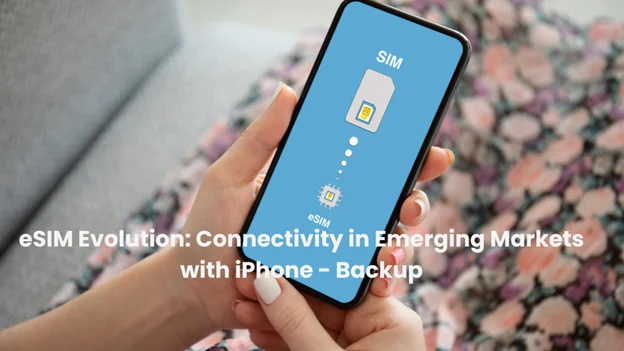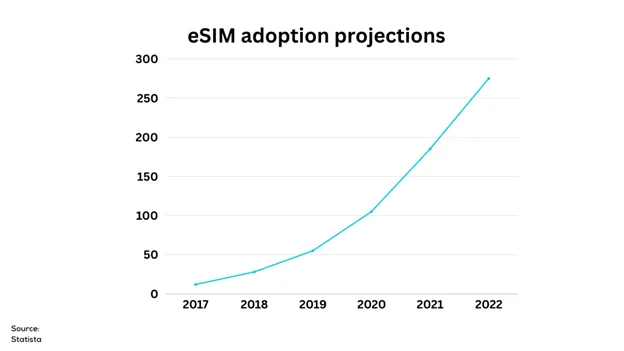eSIM Evolution: Connectivity in Emerging Markets with iPhone - Backup
The rise of eSIM (embedded SIM) technology is transforming mobile connectivity globally. This innovation allows users to activate mobile plans remotely without physical SIM cards. With eSIM capabilities, iPhones are accelerating adoption in emerging markets. However, optimizing connectivity requires addressing challenges around implementation, security, and backup.

Key Takeaways
- eSIM technology is transforming mobile connectivity worldwide, enabling remote plan activation and seamless international roaming.
- Emerging markets are poised to benefit significantly from eSIM adoption, thanks to cost savings, infrastructure development, and digital transformation.
- The iPhone's dual eSIM support is a key driver of eSIM adoption in emerging markets.
- Implementing eSIM presents challenges such as consumer awareness, cost concerns, and regulatory issues.
- However, eSIM also offers opportunities for enhanced connectivity, reduced costs, and innovation.
- Protecting eSIM profiles and personal data is crucial.
- Best practices include encryption, two-factor authentication, regular backups, and avoiding public Wi-Fi.
- eSIM adoption is expected to grow rapidly in emerging markets.
- The technology will redefine mobile connectivity, enabling seamless global access and driving digital transformation.
Introduction
eSIM, or embedded SIM, represents a major evolution in connecting mobile networks. Unlike traditional physical SIM cards, eSIM technology enables remote activation of mobile plans. This means you can switch operators and manage multiple profiles through software alone. eSIM simplifies connectivity, unshackling users from physical SIM card logistics.
eSIM technology allows users to have multiple plans active simultaneously. For example, the latest iPhones allow users to install up to eight eSIM profiles and use two numbers at once. This flexibility is unprecedented and simplifies international roaming. It is a standard supported by device makers. eSIM tech is set to change global connectivity.
eSIM’s Global Connectivity Impact
The rise of eSIM technology enhances global mobile network accessibility significantly. With eSIM, international roaming becomes seamless. Users can easily switch profiles across borders. Patients can access emergency services abroad by activating a local plan remotely. eSIM tech allows better network optimization through on-demand operator selection.
To dive deeper into the global impact of eSIM and its transformative potential, Learn more about how this technology is revolutionizing connectivity. For phone companies and device makers, eSIM technology enables them to reach more customers.
It also lets them support customers globally. Consumers benefit from enhanced connectivity options, convenience, and cost savings from eSIM capabilities. The evolution of eSIM is expected to generate over $250 billion in global value by 2025. This shows its transformative potential.
State of eSIM Adoption in Emerging Markets
While bringing connectivity gains worldwide, eSIM technology is especially impactful for emerging markets. Africa, Asia, Latin America, and the Middle East will benefit a lot from eSIM adoption. Factors driving adoption in these markets include:
Cost Savings
eSIM eliminates the distribution, logistics, and material costs of physical SIM cards. This lets operators target new customer segments, including people who need help affording handsets and SIM card plans.
Infrastructure Development
Many emerging markets suffer from inadequate cellular and data connectivity infrastructure. eSIM technology enables easier network expansion and optimization through remote provisioning.
Digital Transformation
eSIM facilitates mobile connectivity, a key enabler of digital transformation. It unlocks applications like digital financial services, telemedicine, online education, and e-governance.
Constraints around consumer awareness and regulatory barriers have slowed the pace of adoption. But the stage is set for rapid growth. eSIM promises huge rewards for all involved.

Accelerating Adoption: iPhone’s Pivotal Role
A key accelerant for eSIM adoption in emerging markets is iPhone availability. With dual eSIM support since the iPhone XS and XR, iPhones are driving eSIM tech into the mainstream.
IPhones account for most eSIM devices, and their share is growing in places like India. Nearly 75% of iPhone users leverage eSIM capabilities to manage multiple mobile plans.
Apple partners with operators like Jio in India. They offer cheap access to iPhone eSIM functionality, driving broader consumer adoption across socioeconomic segments.
The iPhone's eSIM integration prompts networks to improve. It helps operators with infrastructure and service delivery, while seamless connectivity enriches the iPhone user experience.
eSIM is going mainstream globally. The iPhone will keep driving adoption in emerging markets. Apple's user-friendly interface for managing eSIM profiles is accelerating consumer acceptance.
Opportunities and Challenges for eSIM Implementation
However, some challenges limit adoption and use of eSIM in emerging markets:
- Lack of consumer awareness around eSIM benefits and functionality.
- Cost concerns about eSIM-enabled handsets.
- Regulatory issues around standards compliance and policy.
- Technical constraints of network infrastructure.
Simultaneously, eSIM technology creates opportunities by:
- Enhancing connectivity through remote plan activation.
- Reducing costs for operators and consumers.
- Supporting innovation in handsets, apps, and networks.
- Accelerating digital transformation across finance, healthcare, education, and retail sectors.
Regulators, operators, and device makers must collaborate. They must do so to address the challenges. This is how the promises of eSIM can be realized through collaboration.
The Road Ahead: eSIM’s Connectivity Impact
Despite the challenges, eSIM adoption seems poised for massive growth in emerging markets. According to projections, over 70% of mobile connections will be eSIM-enabled by 2025.
Smartphone use is emerging, and 4G and 5G coverage are increasing. This makes emerging markets ripe for eSIM tech, which has digital payments, telemedicine, branchless banking applications, and beyond.
eSIM can cut mobile plan costs, ease network administration, and help bridge digital divides, which are still common across much of Africa, Asia, Latin America, and the Middle East.
Ultimately, the eSIM evolution will redefine mobile connectivity globally. It benefits consumers, operators, and device makers. It also helps service providers. It is a truly transformative technology.
eSIM Technology: Backup and Security
As consumers and enterprises embrace eSIM devices. Practices around security and data backup grow in importance. As eSIM profiles contain sensitive subscriber data, protecting them is critical.
Here are some best practices that can help keep your eSIM profiles and personal data secure:
- Encrypt your iPhone and enable two-factor authentication for Apple ID.
- Use strong and unique passwords for each eSIM profile.
- Back up eSIM profiles through iCloud or locally through iTunes.
- Enable Find My iPhone to remotely erase data if your phone is lost or stolen.
- Delete eSIM profiles when switching devices or mobile plans.
- Avoid public Wi-Fi networks and install a VPN for safer browsing.
- Review cellular plan invoices regularly to detect any unauthorized usage.
With proper precautions, users can benefit greatly from eSIM technology. It won't harm data privacy and security. iPhone connectivity is embedded in our lives with eSIM. Following best practices around backup and protection is essential.
Conclusion
The eSIM evolution will greatly redefine mobile connectivity. It will do this through remote setup and instant plan activation. With the iPhone accelerating mainstream adoption, consumers globally stand to benefit. However, harnessing its potential requires stakeholder collaboration to address implementation challenges. As the eSIM transformation gathers momentum, data security and backup will be crucial. In the end, the stage is set for eSIM. It will unlock the next era of seamless global connectivity.
FAQ's
Q. How does the iPhone backup work with eSIM?
A. You can securely back up iPhone eSIM profiles through iCloud or iTunes. All eSIM details, such as operator profiles and credentials, are encrypted. Restoring from the backup automatically downloads the eSIM plan without reactivation.
Q. Can I transfer my eSIM profiles to other devices?
A. eSIM profiles are device-dependent, but transferring between iPhones is possible. You must deregister the eSIM by resetting network settings before moving to another iPhone with the same Apple ID.
Q. What security measures protect my eSIM data?
A. Apple provides robust encryption for eSIM data on iPhones. We secure activation credentials using hardware keys, which unauthorized parties cannot access. Network operators also authenticate eSIM profiles during activation and use.